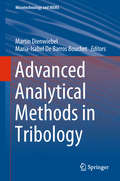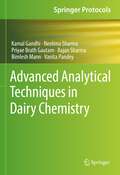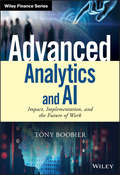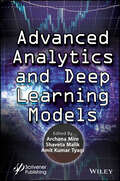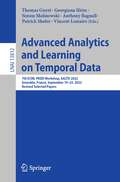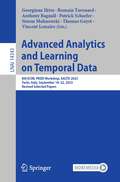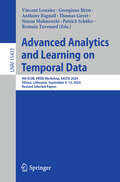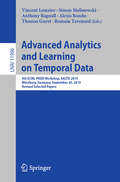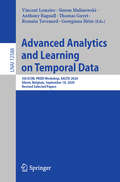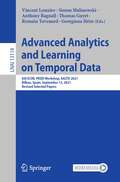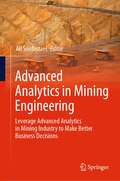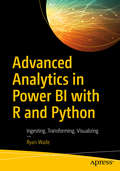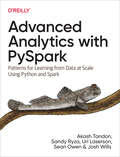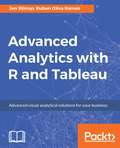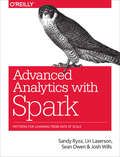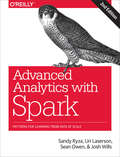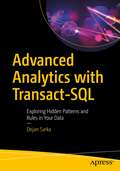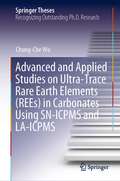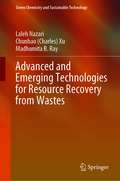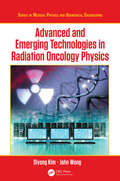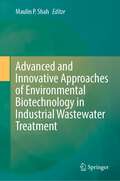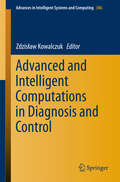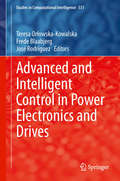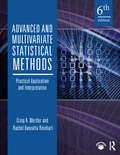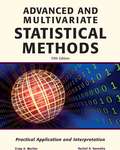- Table View
- List View
Advanced Analytical Methods in Tribology (Microtechnology and MEMS)
by Martin Dienwiebel Maria-Isabel De Barros BouchetThis book presents the basics and methods of nanoscale analytical techniques for tribology field. It gives guidance to the application of mechanical, microstructural, chemical characterization methods and topography analysis of materials. It provides an overview of the of state-of-the-art for researchers and practitioners in the field of tribology. It shows different examples to the application of mechanical, microstructural, chemical characterization methods and topography analysis of materials. Friction and Wear phenomena are governed by complexe processes at the interface of sliding surfaces. For a detailed understanding of these phenomena many surface sensitive techniques have become available in recent years. The applied methods are atom probe tomography, in situ TEM, SERS, NEXAFS, in situ XPS, nanoindentation and in situ Raman spectroscopy. A survey of new related numerical calculations completes this book. This concerns ab-initio coupling, numerical calculations for mechanical aspects and density functional theory (DFT) to study chemical reactivity.
Advanced Analytical Techniques in Dairy Chemistry (Springer Protocols Handbooks)
by Rajan Sharma Kamal Gandhi Priyae Brath Gautam Bimlesh Mann Neelima Sharma Vanita PandeyThis book compiles the advanced analytical techniques used in Dairy Chemistry research. It begins with the basic laboratory techniques and progresses towards techniques like spectroscopy, membrane processes, Western blotting etc. It provides step-by-step protocols for easy reproduction. It also provides troubleshooting guides. This one-of-a-kind protocols book is specifically designed for techniques used in Dairy Science research. It discusses all the necessary steps in different techniques, starting from sample preparations, standardizations and safety measures. It discusses the different techniques in assessing the quality of milk and milk products especially concerning to adulteration. It also includes the techniques used in assessing the active components in functional foods. The book is meant for students and researchers working in the field of Dairy and Food science. It is also useful for experts in the Dairy Industry.
Advanced Analytics and AI: Impact, Implementation, and the Future of Work (Wiley Finance)
by Tony BoobierBe prepared for the arrival of automated decision making Once thought of as science fiction, major corporations are already beginning to use cognitive systems to assist in providing wealth advice and also in medication treatment. The use of Cognitive Analytics/Artificial Intelligence (AI) Systems is set to accelerate, with the expectation that it’ll be considered ‘mainstream’ in the next 5 – 10 years. It’ll change the way we as individuals interact with data and systems—and the way we run our businesses. Cognitive Analysis and AI prepares business users for the era of cognitive analytics / artificial intelligence. Building on established texts and commentary, it specifically prepares you in terms of expectation, impact on personal roles, and responsibilities. It focuses on the specific impact on key industries (retail, financial services, utilities and media) and also on key professions (such as accounting, operational management, supply chain and risk management). Shows you how users interact with the system in natural language Explains how cognitive analysis/AI can source ‘big data’ Provides a roadmap for implementation Gets you up to speed now before you get left behind If you’re a decision maker or budget holder within the corporate context, this invaluable book helps you gain an advantage from the deployment of cognitive analytics tools.
Advanced Analytics and Deep Learning Models (Next Generation Computing and Communication Engineering)
by Archana Mire Shaveta Malik Amit Kumar TyagiAdvanced Analytics and Deep Learning Models The book provides readers with an in-depth understanding of concepts and technologies related to the importance of analytics and deep learning in many useful real-world applications such as e-healthcare, transportation, agriculture, stock market, etc. Advanced analytics is a mixture of machine learning, artificial intelligence, graphs, text mining, data mining, semantic analysis. It is an approach to data analysis. Beyond the traditional business intelligence, it is a semi and autonomous analysis of data by using different techniques and tools. However, deep learning and data analysis both are high centers of data science. Almost all the private and public organizations collect heavy amounts of data, i.e., domain-specific data. Many small/large companies are exploring large amounts of data for existing and future technology. Deep learning is also exploring large amounts of unsupervised data making it beneficial and effective for big data. Deep learning can be used to deal with all kinds of problems and challenges that include collecting unlabeled and uncategorized raw data, extracting complex patterns from a large amount of data, retrieving fast information, tagging data, etc. This book contains 16 chapters on artificial intelligence, machine learning, deep learning, and their uses in many useful sectors like stock market prediction, a recommendation system for better service selection, e-healthcare, telemedicine, transportation. There are also chapters on innovations and future opportunities with fog computing/cloud computing and artificial intelligence. Audience Researchers in artificial intelligence, big data, computer science, and electronic engineering, as well as industry engineers in healthcare, telemedicine, transportation, and the financial sector. The book will also be a great source for software engineers and advanced students who are beginners in the field of advanced analytics in deep learning.
Advanced Analytics and Learning on Temporal Data: 7th ECML PKDD Workshop, AALTD 2022, Grenoble, France, September 19–23, 2022, Revised Selected Papers (Lecture Notes in Computer Science #13812)
by Thomas Guyet Georgiana Ifrim Simon Malinowski Anthony Bagnall Patrick Shafer Vincent LemaireThis book constitutes the refereed proceedings of the 7th ECML PKDD Workshop, AALTD 2022, held in Grenoble, France, during September 19–23, 2022.The 12 full papers included in this book were carefully reviewed and selected from 21 submissions. They were organized in topical sections as follows: Oral presentation and poster presentation.
Advanced Analytics and Learning on Temporal Data: 8th ECML PKDD Workshop, AALTD 2023, Turin, Italy, September 18–22, 2023, Revised Selected Papers (Lecture Notes in Computer Science #14343)
by Georgiana Ifrim Romain Tavenard Anthony Bagnall Patrick Schaefer Simon Malinowski Thomas Guyet Vincent LemaireThis volume LNCS 14343 constitutes the refereed proceedings of the 8th ECML PKDD Workshop, AALTD 2023, in Turin, Italy, in September 2023. The 20 full papers were carefully reviewed and selected from 28 submissions. They are organized in the following topical section as follows: Machine Learning; Data Mining; Pattern Analysis; Statistics to Share their Challenges and Advances in Temporal Data Analysis.
Advanced Analytics and Learning on Temporal Data: 9th ECML PKDD Workshop, AALTD 2024, Vilnius, Lithuania, September 9–13, 2024, Revised Selected Papers (Lecture Notes in Computer Science #15433)
by Vincent Lemaire Georgiana Ifrim Anthony Bagnall Thomas Guyet Simon Malinowski Patrick Schäfer Romain TavenardThis book constitutes the refereed proceedings of the 9th ECML PKDD workshop on Advanced Analytics and Learning on Temporal Data, AALTD 2024, held in Vilnius, Lithuania, during September 9-13, 2024. The 8 full papers presented here were carefully reviewed and selected from 15 submissions. The papers focus on recent advances in Temporal Data Analysis, Metric Learning, Representation Learning, Unsupervised Feature Extraction, Clustering, and Classification.
Advanced Analytics and Learning on Temporal Data: 4th ECML PKDD Workshop, AALTD 2019, Würzburg, Germany, September 20, 2019, Revised Selected Papers (Lecture Notes in Computer Science #11986)
by Vincent Lemaire Simon Malinowski Anthony Bagnall Alexis Bondu Thomas Guyet Romain TavenardThis book constitutes the refereed proceedings of the 4th ECML PKDD Workshop on Advanced Analytics and Learning on Temporal Data, AALTD 2019, held in Würzburg, Germany, in September 2019. The 7 full papers presented together with 9 poster papers were carefully reviewed and selected from 31 submissions. The papers cover topics such as temporal data clustering; classification of univariate and multivariate time series; early classification of temporal data; deep learning and learning representations for temporal data; modeling temporal dependencies; advanced forecasting and prediction models; space-temporal statistical analysis; functional data analysis methods; temporal data streams; interpretable time-series analysis methods; dimensionality reduction, sparsity, algorithmic complexity and big data challenge; and bio-informatics, medical, energy consumption, on temporal data.
Advanced Analytics and Learning on Temporal Data: 5th ECML PKDD Workshop, AALTD 2020, Ghent, Belgium, September 18, 2020, Revised Selected Papers (Lecture Notes in Computer Science #12588)
by Vincent Lemaire Simon Malinowski Anthony Bagnall Thomas Guyet Romain Tavenard Georgiana IfrimThis book constitutes the refereed proceedings of the 4th ECML PKDD Workshop on Advanced Analytics and Learning on Temporal Data, AALTD 2019, held in Ghent, Belgium, in September 2020. The 15 full papers presented in this book were carefully reviewed and selected from 29 submissions. The selected papers are devoted to topics such as Temporal Data Clustering; Classification of Univariate and Multivariate Time Series; Early Classification of Temporal Data; Deep Learning and Learning Representations for Temporal Data; Modeling Temporal Dependencies; Advanced Forecasting and Prediction Models; Space-Temporal Statistical Analysis; Functional Data Analysis Methods; Temporal Data Streams; Interpretable Time-Series Analysis Methods; Dimensionality Reduction, Sparsity, Algorithmic Complexity and Big Data Challenge; and Bio-Informatics, Medical, Energy Consumption, Temporal Data.
Advanced Analytics and Learning on Temporal Data: 6th ECML PKDD Workshop, AALTD 2021, Bilbao, Spain, September 13, 2021, Revised Selected Papers (Lecture Notes in Computer Science #13114)
by Vincent Lemaire Simon Malinowski Anthony Bagnall Thomas Guyet Romain Tavenard Georgiana IfrimThis book constitutes the refereed proceedings of the 6th ECML PKDD Workshop on Advanced Analytics and Learning on Temporal Data, AALTD 2021, held during September 13-17, 2021. The workshop was planned to take place in Bilbao, Spain, but was held virtually due to the COVID-19 pandemic. The 12 full papers presented in this book were carefully reviewed and selected from 21 submissions. They focus on the following topics: Temporal Data Clustering; Classification of Univariate and Multivariate Time Series; Multivariate Time Series Co-clustering; Efficient Event Detection; Modeling Temporal Dependencies; Advanced Forecasting and Prediction Models; Cluster-based Forecasting; Explanation Methods for Time Series Classification; Multimodal Meta-Learning for Time Series Regression; and Multivariate Time Series Anomaly Detection.
Advanced Analytics in Mining Engineering: Leverage Advanced Analytics in Mining Industry to Make Better Business Decisions
by Ali SoofastaeiIn this book, Dr. Soofastaei and his colleagues reveal how all mining managers can effectively deploy advanced analytics in their day-to-day operations- one business decision at a time.Most mining companies have a massive amount of data at their disposal. However, they cannot use the stored data in any meaningful way. The powerful new business tool-advanced analytics enables many mining companies to aggressively leverage their data in key business decisions and processes with impressive results.From statistical analysis to machine learning and artificial intelligence, the authors show how many analytical tools can improve decisions about everything in the mine value chain, from exploration to marketing.Combining the science of advanced analytics with the mining industrial business solutions, introduce the “Advanced Analytics in Mining Engineering Book” as a practical road map and tools for unleashing the potential buried in your company’s data.The book is aimed at providing mining executives, managers, and research and development teams with an understanding of the business value and applicability of different analytic approaches and helping data analytics leads by giving them a business framework in which to assess the value, cost, and risk of potential analytical solutions. In addition, the book will provide the next generation of miners – undergraduate and graduate IT and mining engineering students – with an understanding of data analytics applied to the mining industry. By providing a book with chapters structured in line with the mining value chain, we will provide a clear, enterprise-level view of where and how advanced data analytics can best be applied. This book highlights the potential to interconnect activities in the mining enterprise better. Furthermore, the book explores the opportunities for optimization and increased productivity offered by better interoperability along the mining value chain – in line with the emerging vision of creating a digital mine with much-enhanced capabilities for modeling, simulation, and the use of digital twins – in line with leading “digital” industries.
Advanced Analytics in Power BI with R and Python: Ingesting, Transforming, Visualizing
by Ryan WadeThis easy-to-follow guide provides R and Python recipes to help you learn and apply the top languages in the field of data analytics to your work in Microsoft Power BI. Data analytics expert and author Ryan Wade shows you how to use R and Python to perform tasks that are extremely hard, if not impossible, to do using native Power BI tools. For example, you will learn to score Power BI data using custom data science models and powerful models from Microsoft Cognitive Services. The R and Python languages are powerful complements to Power BI. They enable advanced data transformation techniques that are difficult to perform in Power BI in its default configuration but become easier by leveraging the capabilities of R and Python. If you are a business analyst, data analyst, or a data scientist who wants to push Power BI and transform it from being just a business intelligence tool into an advanced data analytics tool, then this is the book to help you do that. What You Will Learn Create advanced data visualizations via R using the ggplot2 package Ingest data using R and Python to overcome some limitations of Power Query Apply machine learning models to your data using R and Python without the need of Power BI premium compacity Incorporate advanced AI in Power BI without the need of Power BI premium compacity via Microsoft Cognitive Services, IBM Watson Natural Language Understanding, and pre-trained models in SQL Server Machine Learning Services Perform advanced string manipulations not otherwise possible in Power BI using R and Python Who This Book Is For Power users, data analysts, and data scientists who want to go beyond Power BI’s built-in functionality to create advanced visualizations, transform data in ways not otherwise supported, and automate data ingestion from sources such as SQL Server and Excel in a more concise way
Advanced Analytics with PySpark: Patterns for Learning from Data at Scale Using Python and Spark
by Akash Tandon Sandy Ryza Uri Laserson Sean Owen Josh WillsThe amount of data being generated today is staggering and growing. Apache Spark has emerged as the de facto tool to analyze big data and is now a critical part of the data science toolbox. Updated for Spark 3.0, this practical guide brings together Spark, statistical methods, and real-world datasets to teach you how to approach analytics problems using PySpark, Spark's Python API, and other best practices in Spark programming.Data scientists Akash Tandon, Sandy Ryza, Uri Laserson, Sean Owen, and Josh Wills offer an introduction to the Spark ecosystem, then dive into patterns that apply common techniques-including classification, clustering, collaborative filtering, and anomaly detection, to fields such as genomics, security, and finance. This updated edition also covers NLP and image processing.If you have a basic understanding of machine learning and statistics and you program in Python, this book will get you started with large-scale data analysis.Familiarize yourself with Spark's programming model and ecosystemLearn general approaches in data scienceExamine complete implementations that analyze large public datasetsDiscover which machine learning tools make sense for particular problemsExplore code that can be adapted to many uses
Advanced Analytics with R and Tableau
by Jen Stirrup Ruben Oliva RamosLeverage the power of advanced analytics and predictive modeling in Tableau using the statistical powers of R About This Book • A comprehensive guide that will bring out the creativity in you to visualize the results of complex calculations using Tableau and R • Combine Tableau analytics and visualization with the power of R using this step-by-step guide • Wondering how R can be used with Tableau? This book is your one-stop solution. Who This Book Is For This book will appeal to Tableau users who want to go beyond the Tableau interface and deploy the full potential of Tableau, by using R to perform advanced analytics with Tableau. A basic familiarity with R is useful but not compulsory, as the book will start off with concrete examples of R and will move quickly into more advanced spheres of analytics using online data sources to support hands-on learning. Those R developers who want to integrate R in Tableau will also benefit from this book. What You Will Learn • Integrate Tableau's analytics with the industry-standard, statistical prowess of R. • Make R function calls in Tableau, and visualize R functions with Tableau using RServe. • Use the CRISP-DM methodology to create a roadmap for analytics investigations. • Implement various supervised and unsupervised learning algorithms in R to return values to Tableau. • Make quick, cogent, and data-driven decisions for your business using advanced analytical techniques such as forecasting, predictions, association rules, clustering, classification, and other advanced Tableau/R calculated field functions. In Detail Tableau and R offer accessible analytics by allowing a combination of easy-to-use data visualization along with industry-standard, robust statistical computation. Moving from data visualization into deeper, more advanced analytics? This book will intensify data skills for data viz-savvy users who want to move into analytics and data science in order to enhance their businesses by harnessing the analytical power of R and the stunning visualization capabilities of Tableau. Readers will come across a wide range of machine learning algorithms and learn how descriptive, prescriptive, predictive, and visually appealing analytical solutions can be designed with R and Tableau. In order to maximize learning, hands-on examples will ease the transition from being a data-savvy user to a data analyst using sound statistical tools to perform advanced analytics. By the end of this book, you will get to grips with advanced calculations in R and Tableau for analytics and prediction with the help of use cases and hands-on examples. Style and approach Tableau (uniquely) offers excellent visualization combined with advanced analytics; R is at the pinnacle of statistical computational languages. When you want to move from one view of data to another, backed up by complex computations, the combination of R and Tableau makes the perfect solution. This example-rich guide will teach you how to combine these two to perform advanced analytics by integrating Tableau with R and create beautiful data visualizations.
Advanced Analytics with Spark
by Sean Owen Sandy Ryza Josh Wills Uri LasersonIn this practical book, four Cloudera data scientists present a set of self-contained patterns for performing large-scale data analysis with Spark. The authors bring Spark, statistical methods, and real-world data sets together to teach you how to approach analytics problems by example.You'll start with an introduction to Spark and its ecosystem, and then dive into patterns that apply common techniques--classification, collaborative filtering, and anomaly detection among others--to fields such as genomics, security, and finance. If you have an entry-level understanding of machine learning and statistics, and you program in Java, Python, or Scala, you'll find these patterns useful for working on your own data applications.Patterns include:Recommending music and the Audioscrobbler data setPredicting forest cover with decision treesAnomaly detection in network traffic with K-means clusteringUnderstanding Wikipedia with Latent Semantic AnalysisAnalyzing co-occurrence networks with GraphXGeospatial and temporal data analysis on the New York City Taxi Trips dataEstimating financial risk through Monte Carlo simulationAnalyzing genomics data and the BDG projectAnalyzing neuroimaging data with PySpark and Thunder
Advanced Analytics with Spark: Patterns for Learning from Data at Scale
by Sandy Ryza Uri Laserson Sean Owen Josh WillsIn the second edition of this practical book, four Cloudera data scientists present a set of self-contained patterns for performing large-scale data analysis with Spark. The authors bring Spark, statistical methods, and real-world data sets together to teach you how to approach analytics problems by example. Updated for Spark 2.1, this edition acts as an introduction to these techniques and other best practices in Spark programming.You’ll start with an introduction to Spark and its ecosystem, and then dive into patterns that apply common techniques—including classification, clustering, collaborative filtering, and anomaly detection—to fields such as genomics, security, and finance.If you have an entry-level understanding of machine learning and statistics, and you program in Java, Python, or Scala, you’ll find the book’s patterns useful for working on your own data applications.With this book, you will:Familiarize yourself with the Spark programming modelBecome comfortable within the Spark ecosystemLearn general approaches in data scienceExamine complete implementations that analyze large public data setsDiscover which machine learning tools make sense for particular problemsAcquire code that can be adapted to many uses
Advanced Analytics with Transact-SQL: Exploring Hidden Patterns and Rules in Your Data
by Dejan SarkaLearn about business intelligence (BI) features in T-SQL and how they can help you with data science and analytics efforts without the need to bring in other languages such as R and Python. This book shows you how to compute statistical measures using your existing skills in T-SQL. You will learn how to calculate descriptive statistics, including centers, spreads, skewness, and kurtosis of distributions. You will also learn to find associations between pairs of variables, including calculating linear regression formulas and confidence levels with definite integration. No analysis is good without data quality. Advanced Analytics with Transact-SQL introduces data quality issues and shows you how to check for completeness and accuracy, and measure improvements in data quality over time. The book also explains how to optimize queries involving temporal data, such as when you search for overlapping intervals. More advanced time-oriented information in the book includes hazard and survival analysis. Forecasting with exponential moving averages and autoregression is covered as well. Every web/retail shop wants to know the products customers tend to buy together. Trying to predict the target discrete or continuous variable with few input variables is important for practically every type of business. This book helps you understand data science and the advanced algorithms use to analyze data, and terms such as data mining, machine learning, and text mining.Key to many of the solutions in this book are T-SQL window functions. Author Dejan Sarka demonstrates efficient statistical queries that are based on window functions and optimized through algorithms built using mathematical knowledge and creativity. The formulas and usage of those statistical procedures are explained so you can understand and modify the techniques presented. T-SQL is supported in SQL Server, Azure SQL Database, and in Azure Synapse Analytics. There are so many BI features in T-SQL that it might become your primary analytic database language. If you want to learn how to get information from your data with the T-SQL language that you already are familiar with, then this is the book for you. What You Will LearnDescribe distribution of variables with statistical measuresFind associations between pairs of variablesEvaluate the quality of the data you are analyzingPerform time-series analysis on your dataForecast values of a continuous variablePerform market-basket analysis to predict customer purchasing patternsPredict target variable outcomes from one or more input variablesCategorize passages of text by extracting and analyzing keywordsWho This Book Is ForDatabase developers and database administrators who want to translate their T-SQL skills into the world of business intelligence (BI) and data science. For readers who want to analyze large amounts of data efficiently by using their existing knowledge of T-SQL and Microsoft’s various database platforms such as SQL Server and Azure SQL Database. Also for readers who want to improve their querying by learning new and original optimization techniques.
Advanced and Applied Studies on Ultra-Trace Rare Earth Elements (Springer Theses)
by Chung-Che WuThis book provides two state-of-the-art quantitative techniques to determine ultra-trace rare earth elements (REEs) in natural carbonates using solution nebulization-inductively coupled plasma mass spectrometry (SN-ICPMS) and laser ablation-inductively coupled plasma mass spectrometry (LA-ICPMS) with respective applications were presented in this dissertation. These techniques were applied to natural carbonates, including corals and stalagmites, to understand volcano eruptions and the impacts on modern biosystem and paleoclimate regimes. In the first SN-ICPMS protocol, direct measurements for femtogram quantity carbonate samples without chemical separation steps can offer accurate and high-precision analysis (±1.9-6.5%, 2σ) with a high sample throughput of 8-10 samples/hr routinely. Application to modern Porites corals collected from South China Sea region, the anomalies of REE contents and Al/Ca ratios associated with micro-domain images, register modern coral reefs could be exacerbated by volcanic eruptions. In the second protocol, a high-sensitivity quantitative open-cell LA-ICPMS technique has been established to allow direct sampling on stalagmite surface in the atmospheric air. This technique improved limits of detection down to sub-ng/g range and promises analyses of carbonate REE profiles at the single digit parts-per-billion (ppb) levels. Application to a 15-cm stalagmite collected from East Timor reveals two peaks of REE contents by at least one order of magnitude, possibly due to volcanic ash preserved in stalagmite. Both improved SN-ICPMS and LA-ICPMS techniques highlight the high-sensitivity and high-temporal-resolution carbonate REE analyses for corals and stalagmites, with great potential to other natural carbonates such as travertine, tufa, and flowstone, benefit our understanding of paleoclimatic and paleoenvironmental dynamics.
Advanced and Emerging Technologies for Resource Recovery from Wastes (Green Chemistry and Sustainable Technology)
by Laleh Nazari Chunbao (Charles) Xu Madhumita B. RayThis book introduces advanced or emerging technologies for conversion of wastes into a variety of high-value chemicals and materials. Energy and resources can be recovered from various residential, industrial and commercial wastes, such as municipal wastewater and sludge, e-waste, waste plastics and resins, crop residues, forestry residues and lignin. Advanced waste-to-resource and energy technologies like pyrolysis, hydrothermal liquefaction, fractionation, de-polymerization, gasification and carbonization are also introduced. The book serves as an essential guide to dealing with various types of wastes and the methods of disposal, recovery, recycling and re-use. As such it is a valuable resource for a wide readership, including graduate students, academic researchers, industrial researchers and practitioners in chemical engineering, waste management, waste to energy and resources conversion and biorefinery.
Advanced and Emerging Technologies in Radiation Oncology Physics (Series in Medical Physics and Biomedical Engineering)
by Siyong Kim John W. WongThis new book educates readers about new technologies before they appear in hospitals, enabling medical physicists and clinicians to prepare for new technologies thoroughly and proactively, and provide better patient care once new equipment becomes available. Emerging technologies in imaging, treatment planning, treatment delivery, dosimetry and informatics are all discussed. The book is divided into three parts: recently developed technologies available for practice; technologies under development nearing completion; and technologies in an early stage of development that could have potential radiotherapy applications. Features: Introduces emerging technologies in imaging, treatment planning, treatment delivery, dosimetry and informatics The advantages and limitations of each technology in clinical settings are discussed, and recommendations on how to adopt the technologies are provided Critiques and improvement points are provided for researchers, in addition to suggestions on how to prepare quality assurance are provided as needed
Advanced and Innovative Approaches of Environmental Biotechnology in Industrial Wastewater Treatment
by Maulin P. ShahThis book discusses new and innovative trends and techniques in the removal of toxic and refractory pollutants by means of various microbial biotechnology processes from wastewater, both on the laboratory and industrial scales. The book also highlights the main factors contributing to the removal of toxic pollutants as well as recycling, environmental impact, and wastewater policies after heavy metal removal. In addition, it assesses the potential application of several existing bioremediation techniques and introduces new cutting-edge emerging technologies. This book significantly contributes to the wastewater treatment plant industry so that the treatment systems can serve better and more resiliently for the purpose. This book is designed for engineers, scientists, and other professionals who are seeking introductory knowledge of the principles of environmental bioremediation technology and for students who are interested in the environmental microbiology and bioremediation fields.
Advanced and Intelligent Computations in Diagnosis and Control (Advances in Intelligent Systems and Computing #386)
by Zdzisław KowalczukThis book is devoted to the demands of research and industrial centers for diagnostics, monitoring and decision making systems that result from the increasing complexity of automation and systems, the need to ensure the highest level of reliability and safety, and continuing research and the development of innovative approaches to fault diagnosis. The contributions combine domains of engineering knowledge for diagnosis, including detection, isolation, localization, identification, reconfiguration and fault-tolerant control. The book is divided into six parts: (I) Fault Detection and Isolation; (II) Estimation and Identification; (III) Robust and Fault Tolerant Control; (IV) Industrial and Medical Diagnostics; (V) Artificial Intelligence; (VI) Expert and Computer Systems.
Advanced and Intelligent Control in Power Electronics and Drives (Studies in Computational Intelligence #531)
by José Rodríguez Frede Blaabjerg Teresa Orłowska-KowalskaPower electronics and variable frequency drives are continuously developing multidisciplinary fields in electrical engineering and it is practically not possible to write a book covering the entire area by one individual specialist. Especially by taking account the recent fast development in the neighboring fields like control theory, computational intelligence and signal processing, which all strongly influence new solutions in control of power electronics and drives. Therefore, this book is written by individual key specialist working on the area of modern advanced control methods which penetrates current implementation of power converters and drives. Although some of the presented methods are still not adopted by industry, they create new solutions with high further research and application potential. The material of the book is presented in the following three parts: Part I: Advanced Power Electronic Control in Renewable Energy Sources (Chapters 1-4), Part II: Predictive Control of Power Converters and Drives (5-7), Part III: Neurocontrol and Nonlinear Control of Power Converters and Drives (8-11). The book is intended for engineers, researchers and students in the field of power electronics and drives who are interested in the use of advanced control methods and also for specialists from the control theory area who like to explore new area of applications.
Advanced and Multivariate Statistical Methods: Practical Application and Interpretation
by Craig A. Mertler Rachel Vannatta Reinhart* All the statistics traditionally covered in a second-level course are included. * Stresses the conceptual and practical aspects for students who do not need emphasis on the underlying mathematical theory. * Students learn not only the purpose of and how to compute the statistics using SPSS, they also learn the logic behind the techniques and how to test the underlying assumptions. * Students are shown how to interpret, present, and write up the results for each technique. * Exercises allow students to practice their newly acquired skills. The answer key will be provided with professors' copies. * If your students are overwhelmed by advanced statistics texts that are too technical and mathematical, you should examine this highly applied approach to multivariate statistics. Covers why, what, when and how. Ideal for nonmath majors. * The numerous screenshots and examples of output make it easy for students to follow the text. * Each statistical method is followed by an explanation of why a student might use that method, including a discussion of its purpose and sample research questions it can address. * The authors also show a sample study with an example of how to write up the results. Students see firsthand how to present their statistical findings. * Although SPSS is the program that is illustrated, students using any program will benefit greatly from the conceptual material.
Advanced and Multivariate Statistical Methods: Practical Application and Interpretation Fifth Edition
by Craig A. Mertler Rachel A. Vannatta* All the statistics traditionally covered in a second-level course are included. * Stresses the conceptual and practical aspects for students who do not need emphasis on the underlying mathematical theory. * Students learn not only the purpose of and how to compute the statistics using SPSS, they also learn the logic behind the techniques and how to test the underlying assumptions. * Students are shown how to interpret, present, and write up the results for each technique. * Exercises allow students to practice their newly acquired skills. The answer key will be provided with professors' copies. * If your students are overwhelmed by advanced statistics texts that are too technical and mathematical, you should examine this highly applied approach to multivariate statistics. Covers why, what, when and how. Ideal for nonmath majors. * The numerous screenshots and examples of output make it easy for students to follow the text. * Each statistical method is followed by an explanation of why a student might use that method, including a discussion of its purpose and sample research questions it can address. * The authors also show a sample study with an example of how to write up the results. Students see firsthand how to present their statistical findings. * Although SPSS is the program that is illustrated, students using any program will benefit greatly from the conceptual material.
